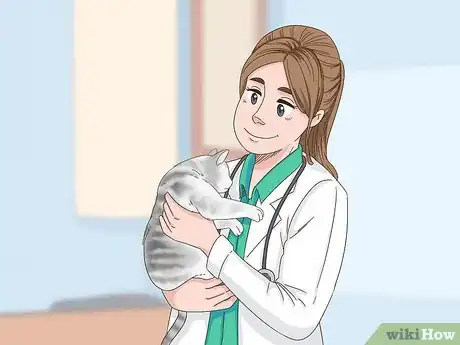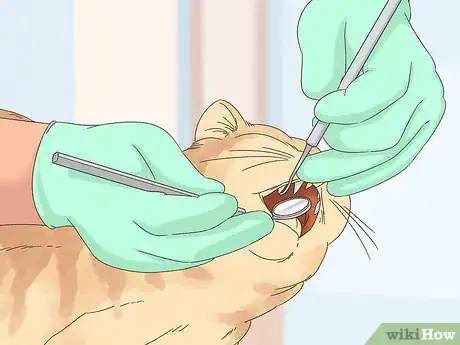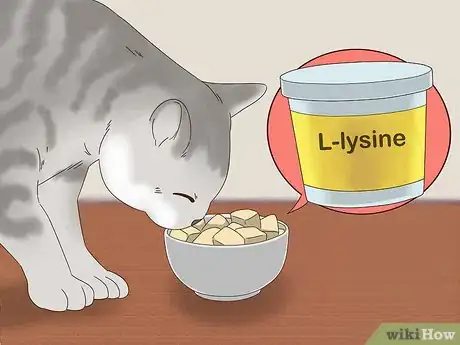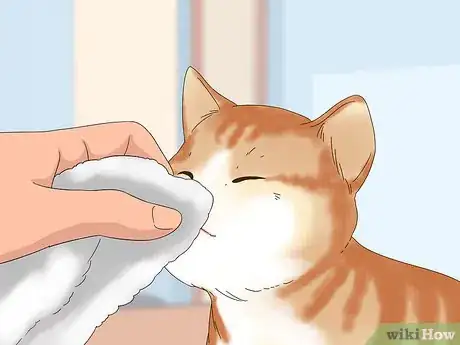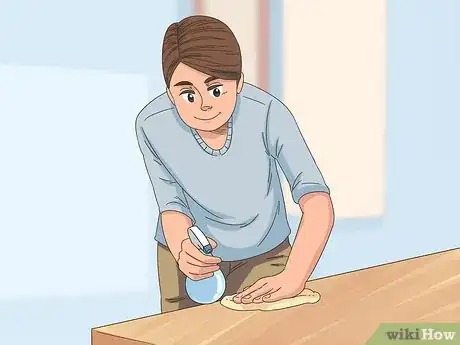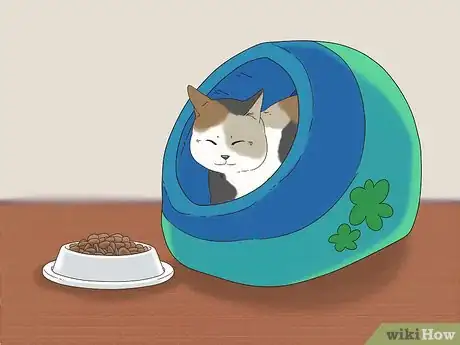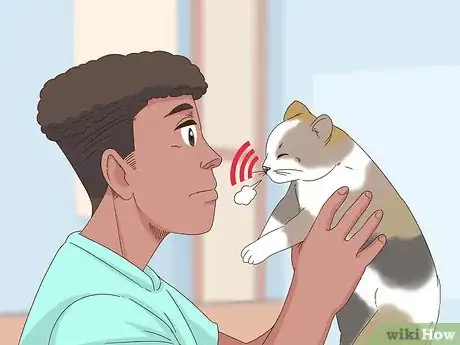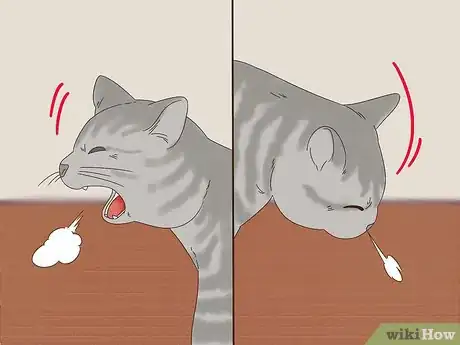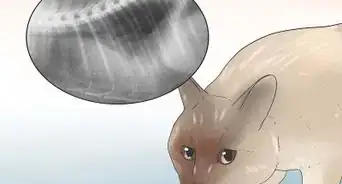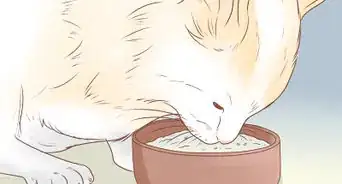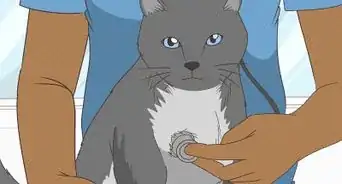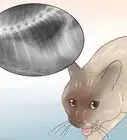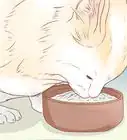This article was co-authored by Lauren Baker, DVM, PhD. Dr. Lauren Baker is a Veterinarian and Assistant Scientist at the University of Wisconsin-Madison. With over 10 years in veterinary medicine, she specializes in the concept of “one health,” which uses insights from veterinary medicine to help human medical research. She holds a Ph.D. in Comparative Biomedical Sciences, a Doctor of Veterinary Medicine, an MS in Comparative Biomedical Sciences, and a Bachelor’s degree in Psychology from the University of Wisconsin-Madison.
This article has been viewed 20,143 times.
When a cat's nose runs all the time it can make their fur unsightly, cause irritation of the skin, and leave moist areas on your furniture and around your house. It also signals that your cat may have a medical condition that needs treatment. If you suspect that your cat has chronic nasal discharge because its nose never stops running, you need to have it treated by a veterinarian and follow up with any at-home treatments that are prescribed.
Steps
Seeking Veterinary Care
-
1Have your cat looked at by a veterinarian. If your cat's nose is running a lot, you should have the cat looked at by a veterinarian. Continual nasal discharge can signal a variety of illnesses that need to be treated by a veterinarian. During the appointment, your veterinarian should ask you about your cat's symptoms, assess your cat's overall health, and give a diagnosis for what is causing your cat's runny nose. Some illnesses that could be causing your cat's runny nose include:[1]
- Upper respiratory infection
- Bacterial infection
- Fungal infection
- Parasites
- Foreign bodies
- Oral disease
- Inflammatory polyps
- Nasal cancer
- Allergies
-
2Follow your veterinarian's instructions for treatment. Once your veterinarian comes up with a diagnosis, they will suggest treatment options for your cat. This will vary depending on your cat's underlying illness, but with chronic nasal discharge your veterinarian will likely prescribe an antibiotic to eliminate any underlying infections.[2]
- Follow your veterinarian's suggestions for treatment, including the amount of medication to give your cat, how to administer it, and how long you should give it to them.
- If your veterinarian finds that your cat has a rare or serious illness, such as nasal cancer, this may require extensive treatment, such as surgery.
Advertisement -
3Treat any dental problems. If your veterinarian suggests that your cat's nasal problems are related to dental issues, you should have those fixed. It may be that your regular veterinarian can do dental procedures on your cat. However, you may need to take your cat to a veterinary dentist if the procedure is complex.[3]
-
4Give your cat supplements. Depending on the cause of the discharge, supplements, such as L-lysine, might be helpful. Discuss the option of supplements with your veterinarian and give to your cat as directed. Do not give your cat supplements without consulting your vet first.[4]
- It is important to discuss any supplements you are giving to your cat with your veterinarian, especially if your cat is already on medication. You want to avoid any dangerous medicine interactions that could occur.
Giving At-Home Care
-
1Clean the cat's nasal area. If your cat has nasal discharge, you should be sure to clean the area daily. Use a soft, damp cloth to clean the area around the nose, making sure that the cat's nostrils are not crusty or clogged up.[5]
- Most cats will resist having their noses wiped. You may have to wrap your cat up in a towel to keep it immobilized while you are cleaning its nose.
-
2Keep your home clean. Nasal discharge can be caused, or at least worsened, by dust and foreign particles. To avoid irritating the nasal and throat passages of your cat, you should clean your home regularly, paying particular attention to removing dust and debris from your cat's favorite areas.[6]
- Try switching your cat litter to a reduced-dust or dust-free variety.
- In addition to cleaning, you can purchase and install an air purifier in your home to keep the air clean.
-
3Provide extra care at home. As your cat is recuperating from chronic nasal discharge, you should pamper it a little bit. Make sure it is getting lots of rest, getting nutritious meals, and lots of extra love and attention. Making sure that your cat stays warm and gets the extra rest it needs to fight off an infection will go a long way towards speeding its recovery.
- This is especially helpful in cases where no cause to the nasal discharge is found. All you can do it make sure that your cat is as comfortable as possible and support its immune system by caring for the cat properly.[7]
Identifying the Cause of Chronic Nasal Discharge
-
1Assess the color of the nasal discharge. If your cat has clear versus colored or cloudy nasal discharge it can mean very different things health-wise. In general, clear nasal discharge signals a less serious infection than cloudy or colored nasal discharge does. Although, any type of chronic nasal drip needs to be assessed by a veterinarian, a cat that has brown, green, or blood tinged nasal discharge needs veterinary treatment immediately.[8]
- Clear nasal discharge is often associated with allergies or other health problems not related to infection.
-
2Listen to your cat's breathing. Chronic nasal discharge is often accompanied by wheezing or labored breathing in cats. This signals that your cat likely has an infection in its lungs or another part of its upper respiratory tract.[9]
- If your cat has slight wheezing when it breathes, that is not an emergency in general. However, if your cat is having a hard time breathing or getting full breaths, then that is an emergency and you should take your cat to be seen by a veterinarian immediately.
-
3Pay attention to coughing or sneezing. Coughing and sneezing are symptoms of illness that often goes along with chronic nasal discharge. If your cat is coughing or sneezing in addition to having a runny nose, it could mean that your cat has an upper respiratory infection or another type of infection in its upper respiratory tract.[10]
- If your cat sneezes once in awhile, that does not necessarily mean it is connected to some sort of illness. It is repeated and strong sneezes that are often related to upper respiratory tract illnesses.
-
4Identify any additional symptoms. If you see that your cat has nasal discharge, you should look for other symptoms that could connected to its illness. Any unusual physical symptoms or behavioral issues could be related to your cat's chronic nasal discharge, so make note of them.[11]
- You should make note of any symptoms that you witness on your cat so that you can tell your veterinarian about them. Take note of when the symptoms started and if they are better or worse at any particular times.
References
- ↑ http://www.vetstreet.com/our-pet-experts/what-is-wrong-with-my-snotty-kitty
- ↑ https://vcahospitals.com/know-your-pet/chronic-nasal-discharge-in-cats
- ↑ https://www.avma.org/public/PetCare/Pages/Pet-Dental-Care.aspx
- ↑ https://vcahospitals.com/know-your-pet/chronic-nasal-discharge-in-cats
- ↑ http://www.petmd.com/cat/conditions/respiratory/c_ct_nasal_discharge%20?page=2
- ↑ http://www.petmd.com/cat/conditions/respiratory/c_ct_nasal_discharge%20?page=2
- ↑ https://vcahospitals.com/know-your-pet/chronic-nasal-discharge-in-cats
- ↑ https://vcahospitals.com/know-your-pet/chronic-nasal-discharge-in-cats
- ↑ http://www.vetstreet.com/our-pet-experts/what-is-wrong-with-my-snotty-kitty
About This Article
To stop chronic nasal discharge in your cat, first visit your vet for a diagnosis, since a runny nose can be a symptom of a number of different illnesses that require different types of treatment. For example, if your cat has an upper respiratory infection, you may have to give it a round of antibiotics to treat it. Alternatively, if your cat has dental problems that’s causing it to have a running nose, you may need to set up an appointment to get its teeth repaired. Once you’ve received a treatment plan from your vet, you can alleviate your cat’s symptoms at home by cleaning its nasal area daily. To do this, wipe its nose and the area surrounding it with a soft, damp cloth to clear away the discharge. To learn how to remove dust and debris from your house that may be irritating your cat’s nose, read more from our Veterinary co-author.
